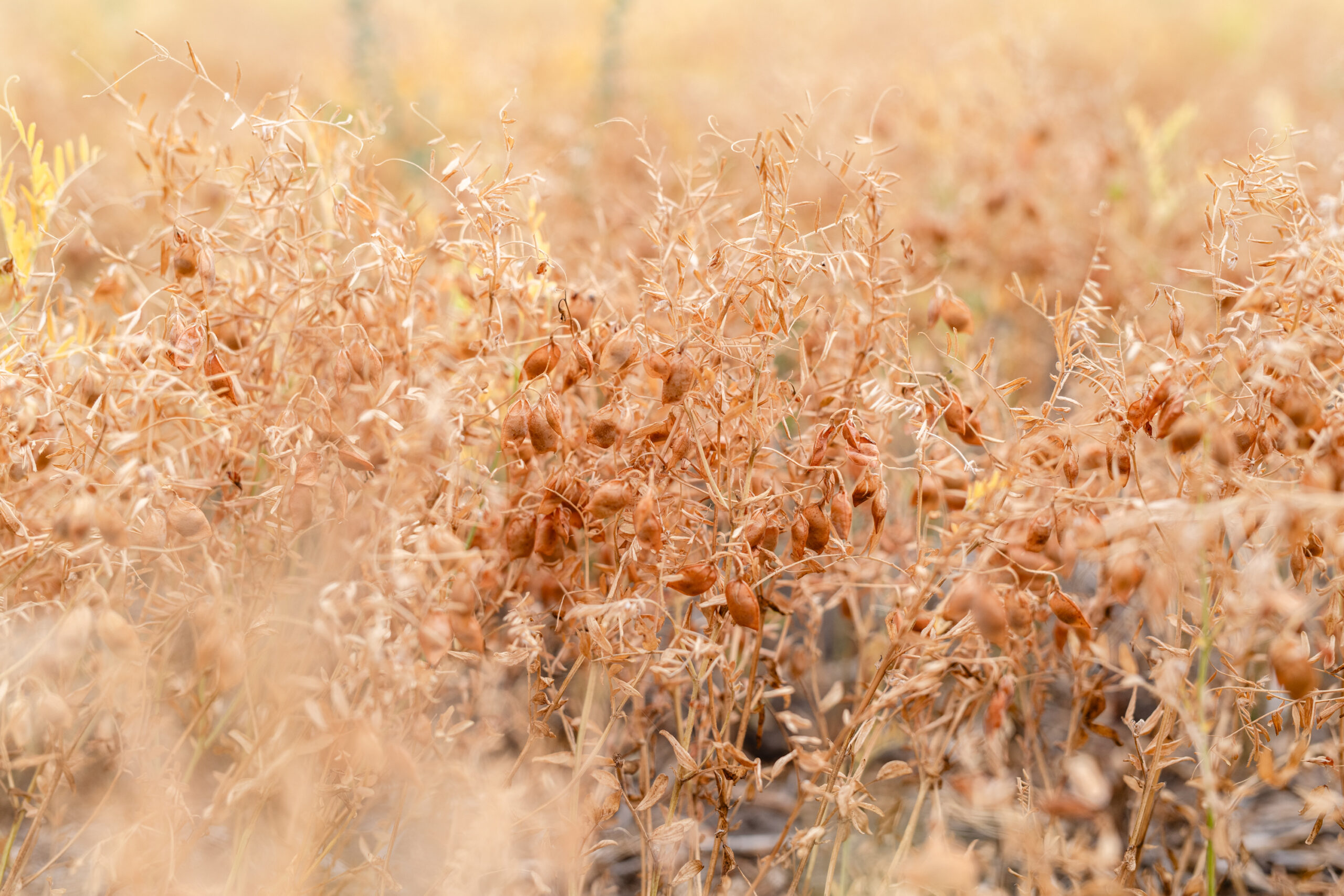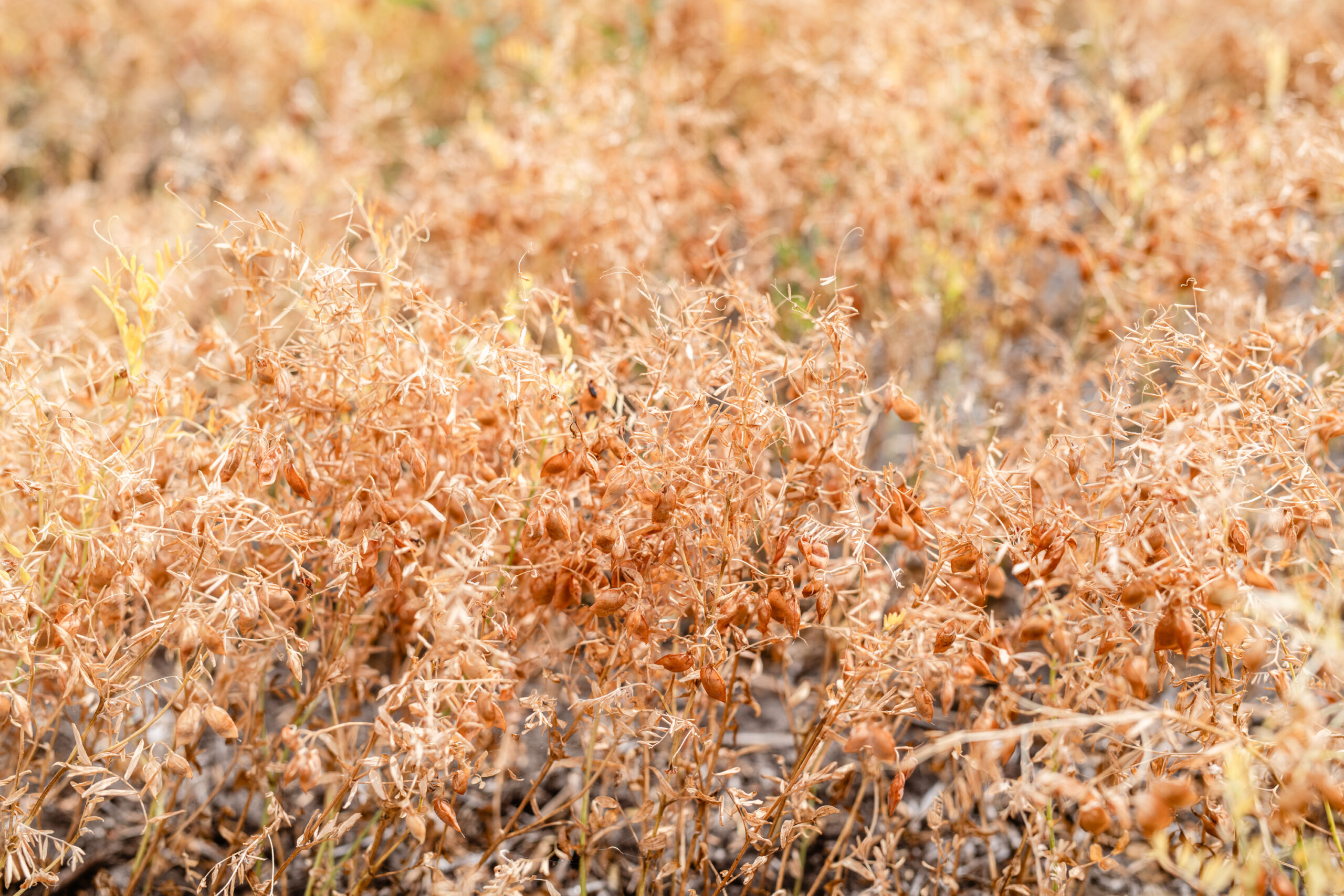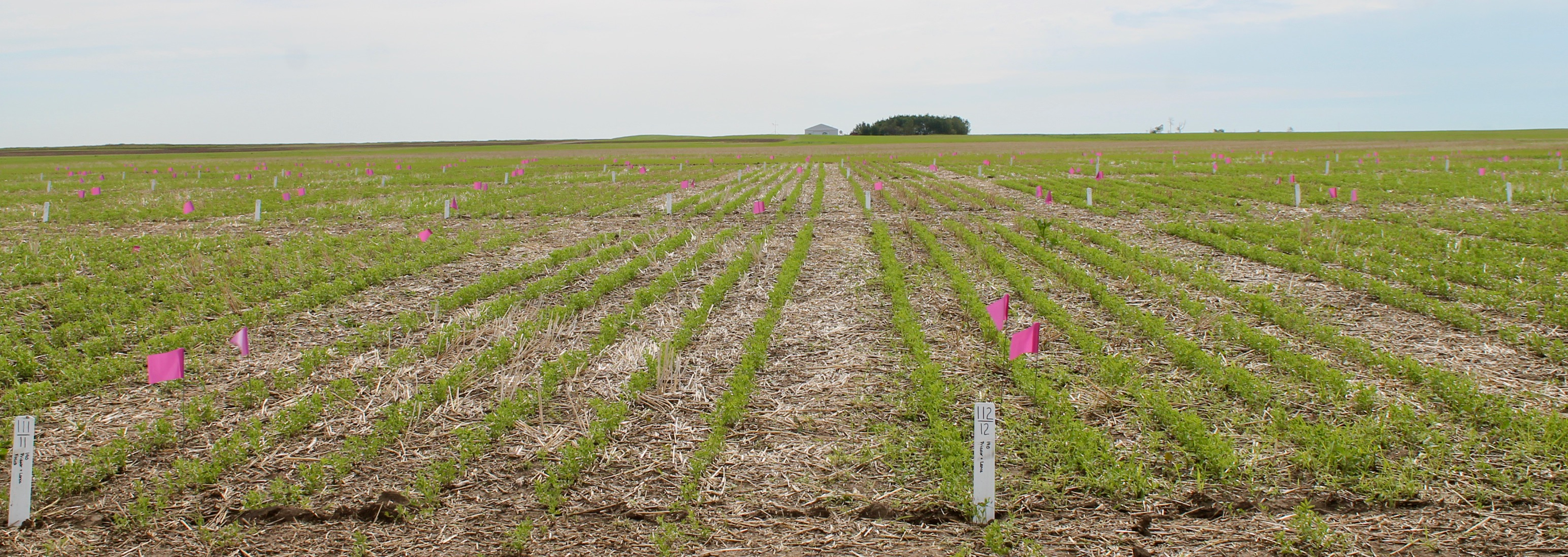Principle Investigator: Chris Holzapfel
Collaborators: Jessica Enns, Bryan Nybo
Introduction
Lentils, being a significant pulse crop in Saskatchewan, incur substantial production costs related to fertilizer and fertility inputs, especially in drier brown- and dark brown-soil zones. Current recommended practices for lentils involve relying on biological nitrogen fixation through rhizobium bacteria, specifically Rhizobium leguminosarum. Inoculants are commonly used to ensure sufficient bacteria populations, and the application of nitrogen fertilizer beyond what is provided by phosphorous and sulfur products is generally discouraged. However, the time required for root nodules to form and facilitate bacterial colonization sometimes necessitates the use of low rates of starter nitrogen, particularly in coarse-textured soils. Regardless, growers need to exercise caution with this approach due to the potential negative impacts on nodulation, nitrogen fixation, and crop yield.
The application of phosphorous fertilizer is also commonly used as a fertility input. Despite lentils’ relatively modest phosphorous requirements, phosphorus is a limiting nutrient in Saskatchewan soils, and positive responses to phosphorus fertilizer have been observed. However, the effectiveness of low initial amounts of nitrogen and phosphorus fertilizers, along with rhizobial inoculants, is inconsistent, emphasizing the need for further research to establish effective fertilizer recommendations and optimize the use of inoculants in lentil production.
To address this research need, Saskatchewan Pulse Growers (SPG) initiated a demonstration project aiming to address the high costs associated with fertilizer and fertility inputs in lentil production. The project aimed to showcase the expected responses to rhizobial inoculation, starter nitrogen applications, and phosphorus fertilization across different soil and climatic zones. Additionally, the project explored the potential benefits of deferred nitrogen applications for increasing yields and grain protein concentrations. The overall objective of this demonstration was to provide practical insights and recommendations to lentil growers, enabling them to optimize their production practices, reduce costs, and improve crop yields and quality.
Materials & Methods
Field trials with small red lentils were conducted at three locations in Saskatchewan: Indian Head, Scott, and Swift Current in 2021 and 2022. The chosen locations were representative of Saskatchewan’s brown, dark brown, and black soil zones.
The treatments were combinations of phosphorus fertilizer rates, granular rhizobial inoculant, and supplementary nitrogen fertilizer applied either at the time of seeding (side-banded) or as an in-season broadcast application targeted for the bud formation stage before flowering (Table 1).
Table 1: Summary of Treatment Application and Source
| Treatment | Source | Application |
|---|---|---|
| Phosphorous Fertilizer | Monoammonium Phosphate (MAP; 11-52-0) | Nitrogen was balanced at 10 kg/ha across the phosphorus rates ranging from 0-45 kg P2O5/ha to ensure that any observed responses were to phosphorus and not the nitrogen provided by the MAP. |
| Granular Rhizobial Inoculant | Nodulator® Duo SCG (BASF; minimum of 8 x 107 CFU/g of Rhizobium leguminosarum biovar viceae STRAIN 1435 and 2 x 108 CFU/g of Bacillus subtilis STRAIN BU1814) | Applied at the label recommended rate, adjusted for row spacing. |
| Supplementary Nitrogen Fertilizer | Urea (46-0-0) | The total nitrogen rate was 55 kg nitrogen/ha where supplemental nitrogen was applied and adjusted for nitrogen provided by the MAP. |
In total, 12 treatments were arranged in a 4-replicate randomized complete block design (RCBD; Table 2). In brief, seeding was completed within the first two weeks of May at all sites with certified seed used in all cases; CDC Proclaim CL at Indian Head and CDC Impulse at Scott and Swift Current. All locations were seeded with a rate of 190 seeds/m2. The seed was treated with fungicides to suppress root diseases at all sites with varying products. Field operations included rolling the plots between seeding and emergence, weed control using pre-emergent and in-crop herbicides, application of foliar fungicides as needed, and pre-harvest herbicides before dry-down and late-season weed control. The lentils were straight combined when it was fit to do so with outside crop rows excluded from the harvest area wherever possible.
Table 2: Fertilizer and inoculant treatments evaluated in lentil fertility demonstrations conducted at Indian Head, Scott, and Swift Current in 2021 and 2022.
| # | Phosphorus Rate (Side-banded MAP) | Granular Inoculant | Extra Nitrogen Fertilizer (adjusted for nitrogen from MAP but not residual NO3-N) |
|---|---|---|---|
| 1 | 0 kg P2O5/ha | No | None |
| 2 | 0 kg P2O5/ha | Yes | None |
| 3 | 22 kg P2O5/ha | No | None |
| 4 | 22 kg P2O5/ha | Yes | None |
| 5 | 45 kg P2O5/ha | No | None |
| 6 | 45 kg P2O5/ha | Yes | None |
| 7 | 45 kg P2O5/ha | No | 55 kg nitrogen/ha sideband |
| 8 | 45 kg P2O5/ha | No | 55 kg nitrogen/ha in-season broadcast |
| 9 | 45 kg P2O5/ha | Yes | 55 kg nitrogen/ha sideband |
| 10 | 45 kg P2O5/ha | Yes | 55 kg nitrogen/ha in-season broadcast |
| 11 | 67 kg P2O5/ha | Yes | None |
| 12 | 67 kg P2O5/ha | Yes | 55 kg nitrogen/ha sideband |
Data collection occurred during the growing season and from the harvested seed and included several endpoints (Table 3). Before the analyses, data from Scott and Swift Current in 2021 was removed due to extreme variability resulting from drought and generally unfavourable environmental conditions. Data from the remaining four sites were combined and analyzed using the generalized linear mixed model. Site (S), fertility treatment (F) and the site by fertility treatment (S x F) interaction were considered as well as replicate effects (within site).
Table 3: Endpoints and collection method for the data processed in this demonstration.
| Endpoint | Method |
|---|---|
| Residual Nutrient Level and Soil Characteristics | Estimated from composite soil samples collected in early spring |
| Spring Plant Densities | Determined by counting seedlings in 2 x 1 m sections of crop row after emergence |
| Seed Yields | Determined from harvested grain samples and adjusted for dockage and seed moisture content of 13% |
| Test Weight | Determined using standard CGC methodology and expressed as g/0.5L |
| Seed Weight | Determined by counting a minimum of 250 whole seeds per plot and expressed as grams/1000 seeds |
| Seed Protein | Determined using a FOSS NIR analyzer with two cleaned sub-samples per plot |
| Daily Temperatures and Precipitation | Recorded from the nearest Environment and Climate Change Canada weather station for each location |
Results
Growing Season Weather & Residual Soil Nutrients
Mean monthly temperatures and precipitation amounts for May to August of each site are presented relative to long-term (1981–2010) averages. In 2021, Indian Head experienced slightly above-average temperature (103%) and above-average precipitation (121%). However, the rain occurred mostly in August, too late to benefit the crop. Regardless, the crop maintained a reasonably high yield. In 2022, Indian Head had average temperatures (101%) and above-average precipitation (117%) from May through August, resulting in a high yield potential. Despite warmer (105–106%) and drier (83–88%) conditions than usual, Scott and Swift Current still achieved reasonably high yields.
The soil test results showed variations among the sites. Near Indian Head, the sites had alkaline soil (pH 8.1), 4.7–4.9% organic matter, and a cation exchange capacity (CEC) of 47–52 millequivalents per 100 grams (meg/100 grams). Scott had the most acidic soil (pH 5.8), 4.2% organic matter, and lower CEC (13 meg/100 grams). Residual NO3-N at Indian Head was 21 kg N/ha in 2021 and 50 kg N/ha in 2022, while Olsen-P was consistently low at 2-4 ppm. Scott had the most acidic soil (pH 5.8), 4.2% organic matter, and lower CEC (13meg/100 grams). Residual NO3-N was 44kg/ha, and Olsen-P was 8 ppm. Swift current had a pH of 6.1, 2.7% organic matter, and a CEC of 19 meg/100 grams. Residual NO3-N was estimated at 33 kg/ha, and Olsen-P was higher at 15 ppm compared to other sites.
Overall Site & Treatment Effects
Model fit was improved by permitting heterogeneous variance estimates (by site) for plant density, seed weight, and protein, but not for seed yield or test weight. The analyses of the data suggested site effect was highly significant for all response variables (P < 0.001). Emergence was not affected by fertility treatment (P = 0.568) and there was no S x F interaction (P = 0.492). Yield and test weight were affected by fertility treatment (P < 0.001-0.031) but the S x F interaction was not significant (P = 0.305-0.383). For thousand seed weight, the overall treatment effect was not significant (P = 0.987); however, a significant S x F interaction (P = 0.047) suggested that site-to-site inconsistencies for this variable (P = 0.047) existed. Notably, seed protein was not affected by fertility treatment and there was no S x F interaction detected (P = 0.835–0.940).
Emergence
Emergence significantly varied with environmental conditions (P < 0.001) but was not affected by the treatments in any cases; thus, indicating that side-banding provided adequate separation between the seed and fertilizer. The lowest mortality occurred in both years at Indian Head, with mean plant populations of 175–177 plants/m2. In 2022, Scott had an intermediate plant population (148 plants/m2) and the highest mortality was observed at Swift Current in 2022 (98 plants/m2). Emergence within sites was consistent with no significant fertility treatment effects or S x F interactions detected.
Seed Yield
The overall fertility effect across sites was significant; the lowest seed yields were observed with no phosphorus fertilizer (2,388–2,390 kg/ha), and the highest yields were observed when phosphorus fertilizer and other inputs were added (2,525–2,666 kg/ha). Yields were highest at Indian Head, intermediate at Scott, and lowest at Swift Current. Breaking down these responses to their individual sources, lentil yields increased linearly with increased phosphorous fertilizer rates at Indian Head in 2021 and 2022. Scott 2022 had a quadratic response as well as linear response, where yields peaked at 22kg P2O5/ha, and Swift Current did not show a significant effect related to phosphorus fertilizer application. These results could be connected to the residual phosphorus levels at each site. The more linear responses occurred at sites with low residual phosphorus levels like Indian Head 2021 and 2022, whereas Scott 2022 had intermediate residual levels, and Swift Current, where no response was observed, had relatively high residual phosphorus levels.
No yield benefits to rhizobial inoculation were detected at any locations regardless of whether supplemental nitrogen was added, and this was observed overall and at individual sites (Figure 1). This could be due to high background levels of Rhizobium leguminosarum in the soil that were sufficient to colonize the roots and biologically fixate the necessary nitrogen to achieve the maximum yield potential. Even in the treatments where supplemental nitrogen was applied, the levels provided would not have been sufficient to support high yields without fixation.
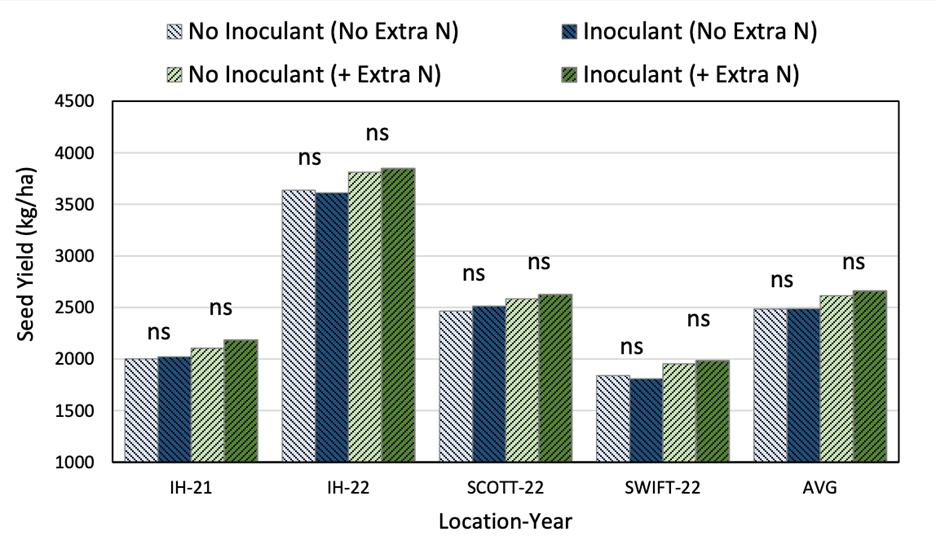
Further to that point, responses to extra nitrogen were inconsistent and small but did occur; average yields were higher with supplemental nitrogen when combined with inoculant compared to the unfertilized treatment combined with inoculant (Figure 2). For individual sites, positive yield responses to supplemental nitrogen were detected at Swift Current and Indian Head in 2022 in the presence and absence of inoculant, respectively. These responses were both expected and unexpected in the sense that at Indian Head, it was expected that responses would occur in the absence of inoculant, but not at the environmental conditions detected. Indian Head had the finest soil texture, highest organic matter, and highest residual soil nitrogen levels. It is possible that, given these conditions, yields were very high and biological nitrogen fixation could not meet the plants’ nitrogen needs, hence the response to supplemental nitrogen added during this demonstration. In contrast, the conditions at Swift Current (driest and coarsest soil with low organic matter), suggested it would benefit the most from supplemental nitrogen, however this benefit was only observed when combined with inoculant which was not the expected result.
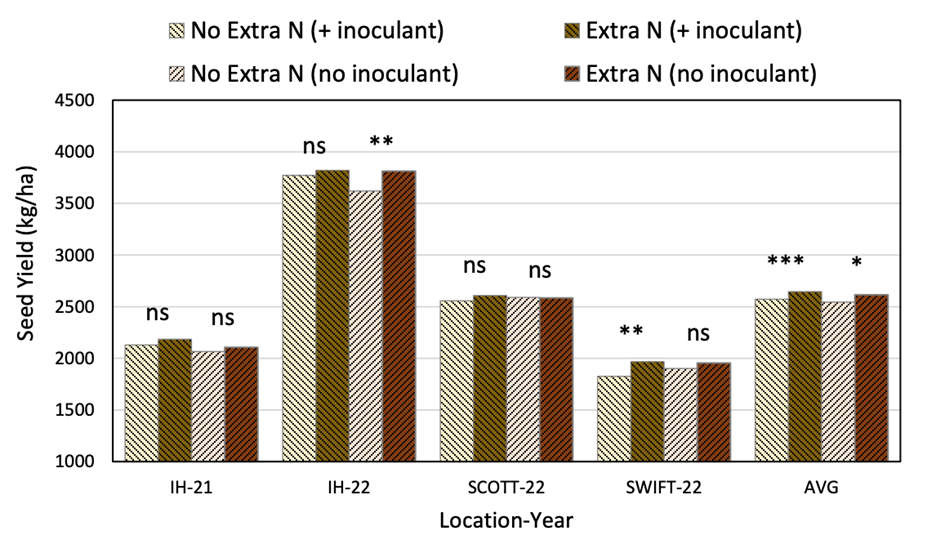
Test Weight
Lentil test weights were highest at Indian Head 2022, followed by Indian Head 2021, Scott 2022, and Swift Current 2022. While the overall impact of fertility on test weight was significant, with the test weight means across sites ranging from 389–406 g/0.5L and the observed means for fertility treatments ranged from 396.6–398 g/0.5L, the magnitude of any effects was small relative to those of environment, and significant impacts were only observed at Scott 2022 and Swift Current 2022.
Breaking down the fertility response to individual treatments, the overall test weight response to phosphorus fertilizer rate was quadratic in that peak effects were observed at 45 kg P2O5/ha before declining; however, this response was most pronounced and only significant in Scott 2022 (Figure 3). Granular inoculant did not have any impact on test weight for individual sites or when averaged across sites, although, in Scott 2022, there was a trend for slightly higher test weight with inoculant specifically when no supplemental nitrogen was applied. Nitrogen fertilizer effects on test weight were not significant when averaged across sites. The only exception amongst individual sites was Swift Current 2022 where extra nitrogen, in the absence of inoculant, resulted in a slight reduction in test weight.
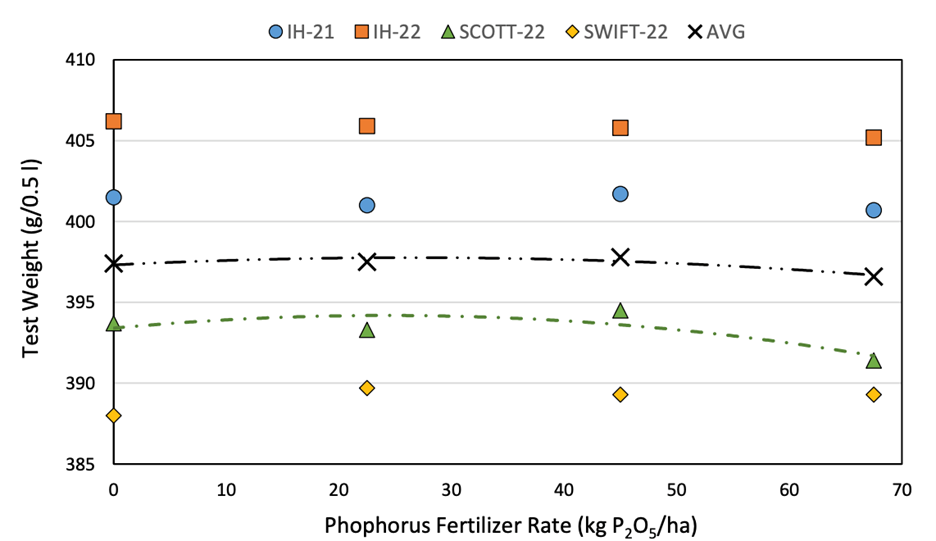
Seed Weight
The overall average seed weight was highest at Scott 2022, intermediate at Swift Current 2022, and lowest at Indian Head in both years (Table 4). However, the lower seed weights at Indian Head were likely partly due to genetics as, according to the 2022 Saskatchewan Seed Guide, CDC Proclaim, the variety used at Indian Head, has a lower seed weight (40 g/1,000 seeds) than CDC Impulse (44 g/1,000 seeds).
Overall, fertility treatments had no significant effect on seed weight (Table 4), and no linear or quadratic responses for phosphorus rate were detected at any individual sites, or when averaged across sites. The addition of granular inoculant and supplemental nitrogen also appeared to have no significant effect on seed weight, apart from a slight decrease in response to supplementing nitrogen regardless of whether inoculant was used at Scott in 2022, and a slight increase when granular inoculant and supplemental nitrogen were combined at Swift Current in 2022. While a significant S x F interaction (P = 0.047) was noted overall, it was concluded that the treatment effects on seed weight were too small and inconsistent to be of much practical agronomic importance.
Table 4: Effect of fertility treatments on lentil seed weight
| Site | Average Seed Weight (gram/1000 seeds) | Impact of Fertility Treatments | Response to Phosphorus | Response to Granular Inoculant | Response to Supplemental Nitrogen |
|---|---|---|---|---|---|
| Indian Head 2021 | 42.9 | Not significant (P = 0.888) | Not significant (P = 0.923 -0.519) | Not significant with or without supplemental nitrogen (P = 0.977, 0.519) | Not significant with or without inoculant (P = 0.630, 0.380) |
| Indian Head 2022 | 43 | Not significant (P = 0.22) | Not significant (P = 0.249 -0.316) | Not significant with or without supplemental nitrogen (P = 0.77, 0.943) | Not significant with or without inoculant (P = 0.311, 0.115) |
| Scott 2022 | 49.6 | Not significant (P = 0.054) | Not significant (P = 0.923 – 0.519) | Not significant with or without supplemental nitrogen (P = 0.725, 0.616) | Slight decrease with inoculant (P = 0.018-0.050) |
| Swift Current 2022 | 46.5 | Not significant (P = 0.276) | Not significant (P = 0.206 – 0.641) | Slight increase with supplemental nitrogen (P = 0.05) | Slight increase with inoculant (P = 0.002) |
| Overall | Not significant (P = 0.987) | Not significant (P = 0.879 -0.788) | Not significant (P = 0.380 – 0.861) | Not significant (P = 0.193 – 0.930) |
Seed Protein
There was no quantifiable impact on seed protein content related to fertility treatment regardless of the statistical tests used. However, protein concentrations did vary with location, averaging 26.6% at Indian Head (both years), 24.2% at Swift Current 2022 and 23.8% at Scott 2022. While higher seed protein is desirable in many pulse crops including lentils, any potential side effects are confounded with seed genetics, and it was concluded that seed protein is more likely to be affected by the environment and genetics of the crop rather than fertility management.
Key Findings & Management Recommendations
As with most agronomic decisions, these findings suggest that the actual economic returns associated with fertility treatments vary widely with environmental conditions and crop species. The overall findings and recommendations of this demonstration regarding lentil responses to various combinations of phosphorus fertilization and nitrogen management are summarized below:
Optimal Seedbed Conditions
Key Finding: The lack of fertility effects on plant establishment indicated that side-band placement provided sufficient separation between the fertilizer and seed row to prevent seedling toxicity and subsequent stand reduction. The strong side effects suggest growers should pay attention to seedbed conditions and monitor seedling mortality on their farms to identify issues and ensure that seeding rates are sufficient to achieve optimal plant stands.
Phosphorous Fertilization
Key Finding: The demonstration indicated that phosphorus application can positively impact lentil yields, especially when residual phosphorus levels in the soil are low. Phosphorus application increased yields at three of the four locations where residual phosphorus levels were low. At Swift Current, residual phosphorus levels were high, and yields were lower.
Recommendations: It is recommended that growers consider soil testing to determine phosphorus status and apply the appropriate fertilizer based on the results. Side-band placement of phosphorus fertilizers is recommended to prevent seedling toxicity and stand reduction.
Nitrogen Management
Key Finding: Treatments of supplemental nitrogen were less pronounced and inconsistent. These findings indicated limited benefits from the application of nitrogen fertilizers and caution should be used when applying nitrogen fertilizer beyond what is supplied by modest rates of phosphorus and sulfur products.
Recommendations: The demonstration suggests that growers can minimize input costs by relying on biological nitrogen fixation and supplementing with modest rates of phosphorus and sulfur fertilizer products. However, if nodulation failures and nitrogen deficiencies are confirmed early in the growing season, in-crop “rescue” applications of nitrogen may be considered.
Inoculation
Key Finding: Lentil crops primarily rely on biological nitrogen fixation for their nitrogen needs. While the study did not observe significant effects of inoculation on nodulation, it is still recommended due to the importance of biological nitrogen fixation.
Recommendations: Growers should consider using inoculant formulations, particularly seed-applied ones, to reduce input costs. This is especially relevant if the field has a history of successful nodulation and no nodulation failures or nitrogen deficiencies have been observed in the past.
